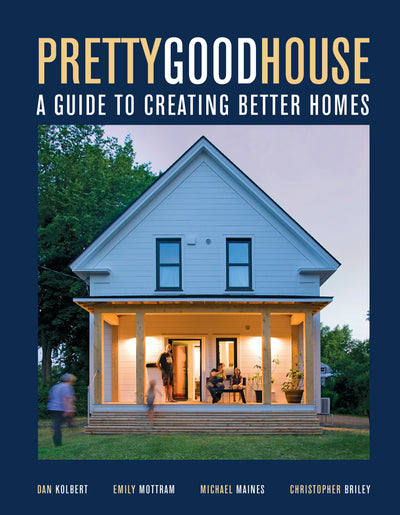You may also like
Pretty Good House
Regular price $34.99 Save $-34.99Pretty Good House provides a framework and set of guidelines for building or renovating a high-performance home that focus on its inhabitants and the environment—but keeps in mind that few people have pockets deep enough to achieve a “perfect” solution. The essential idea is for homeowners to work within their financial and practical constraints both to meet their own needs and do as much for the planet as possible.
A Pretty Good House is:
* A house that's as small as possible
* Simple and durable, but also well designed
* Insulated and air-sealed
* Above all, it is affordable, healthy, responsible, and resilient.

Incorporating Architects
Regular price $29.95 Save $-29.95This forensic analysis traces a history of architects at one such firm, AECOM, as they assembled their own multinational corporation and embedded themselves in the operations of American empire after World War II, shielding themselves from the instabilities of a postwar political economy. Incorporating Architects reveals how architects, through their businesses more than their drawings or buildings, modulated the political economy, gripped the reins of their profession, and produced the global injustices that define our neoliberal present.

Root Shock
Regular price $24.95 Save $-24.95Root Shock examines 3 different U.S. cities to unmask the crippling results of decades-old disinvestment in communities of color and the urban renewal practices that ultimately destroyed these neighborhoods for the advantage of developers and the elite.
Like a sequel to the prescient warnings of urbanist Jane Jacobs, Dr. Mindy Thompson Fullilove reveals the disturbing effects of decades of insensitive urban renewal projects on communities of color. For those whose homes and neighborhoods were bulldozed, the urban modernization projects that swept America starting in 1949 were nothing short of an assault. Vibrant city blocks - places rich in culture - were torn apart by freeways and other invasive development, devastating the lives of poor residents. Fullilove passionately describes the profound traumatic stress- the "root shock"that results when a neighborhood is demolished. She estimates that federal and state urban renewal programs, spearheaded by business and real estate interests, destroyed 1,600 African American districts in cities across the United States. But urban renewal didn't just disrupt black communities: it ruined their economic health and social cohesion, stripping displaced residents of their sense of place as well. It also left big gashes in the centers of cities that are only now slowly being repaired. Focusing on the Hill District of Pittsburgh, the Central Ward in Newark, and the small Virginia city of Roanoke, Dr. Fullilove argues powerfully against policies of displacement. Understanding the damage caused by root shock is crucial to coping with its human toll and helping cities become whole. Mindy Thompson Fullilove, MD, is a research psychiatrist at New York State Psychiatric Institute and professor of clinical psychiatry and public health at Columbia University. She is the author of five books, including Urban Alchemy.

A Framework for Geodesign
Regular price $95.99 Save $-95.99A Framework for Geodesign: Changing Geography by Design presents the key concepts, history, and methodology of geodesign. As an idea, geodesign has the potential to enable more effective and symbiotic collaboration among the several design professions, geographically-oriented sciences, information technologists, and people impacted by change (“the people of the place”) when all of these groups aim to influence major environmental and social change for the better. According to author Carl Steinitz, this collaboration is essential.
Steinitz’s framework, described here in detail, can contribute to that goal. It is clear that for serious societal and environmental issues, designing for change cannot be a solitary activity. It inevitably is a team endeavor with many participants from the design professions and geographic sciences, linked by technology from several locations for rapid communication and feedback, and reliant on transparent communication with the people affected by change. These demands create opportunities for geodesign and the need for organizing that collaboration.
Part I of the book is about the necessary but sometimes difficult collaboration between designers and scientists, and also focuses on key aspects of study areas, scale, and size which influence how geodesign is organized and carried out. Part II presents Steinitz’s framework and addresses six key questions, and their related types of models, which must be integrated in geodesign. Part III features nine case studies that illustrate different ways of designing for change, while Part IV explores the future of geodesign in research, education, and practice.
A Framework for Geodesign ooks mostly to the future, with a primary intention of helping the collaborating participants to achieve, in the words of the author, “practical benefits from geodesign.”

Architecture and Affect in the Middle Ages
Regular price $49.95 Save $-49.95
Historic Landmarks of Philadelphia
Regular price $49.95 Save $-49.95Architectural historian Roger W. Moss and photographer Tom Crane set out to celebrate the surviving accessible historic architecture of Philadelphia, envisioning a series of books that would provide much more than the snapshots found in guidebooks. They began with Historic Houses of Philadelphia, bringing the region's most impressive museum homes to life. Historic Sacred Places of Philadelphia followed, an exclusive tour of fifty hallowed sites. In Historic Landmarks of Philadelphia, Moss and Crane feature prominent, memorable structures that reflect stages in Philadelphia's growth.
There are sixty-five National Historic Landmarks in Philadelphia, structures that have been identified as being "nationally significant" and having "meaning to all Americans." This newest addition to Moss and Crane's trilogy includes a wide array of historic sites, ranging from concert halls to prisons, train stations to museums, banks to libraries. The buildings are arranged chronologically rather than geographically, to emphasize Philadelphia's evolution from modest mercantile outpost of a colonial power, to capital of a proud new nation, to a robust world-renowned cosmopolitan city.
Historic Landmarks of Philadelphia presents such notable attractions as Fort Mifflin, Independence Hall, the Fairmount Water Works, the Athenaeum of Philadelphia, Boathouse Row, Laurel Hill Cemetery, Eastern State Penitentiary, the Academy of Music, the Union League of Philadelphia, Memorial Hall, the Pennsylvania Academy of Fine Arts, the Masonic Temple, and the sights that line the Benjamin Franklin Parkway, including the Philadelphia Museum of Art, the Free Library of Philadelphia, and the Rodin Museum, in more than two hundred color illustrations. It celebrates master builders and their influence on the course of American architecture while identifying the distinctive qualities that embody Philadelphia's history and spirit.
A Barra Foundation Book







